winter botany
Showing 13–24 of 30 results
-
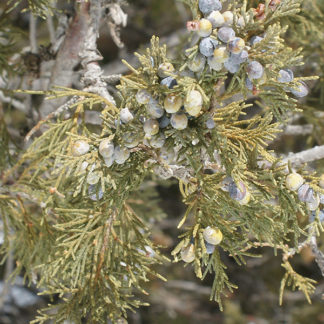
Juniperus scopulorum / Rocky Mountain juniper
- small, rounded evergreen tree (or shrub)
- fibrous, red to grey, shredded bark
- pollen and seed cones at branch tips on separate plants
- female cones blue berries with a waxy, whitish bloom
- leaves on mature plants scale-like
- leaves on young plants are prickly, needle-like
-

Linaria vulgaris / yellow toadflax
- fine, threadlike leaves, plants up to 3 feet tall
- flowers similar to snapdragon, pale yellow with orange lower lip, long spur
- flowers in tight terminal clusters
- plants typically in patches
- "noxious" weed in Idaho
-
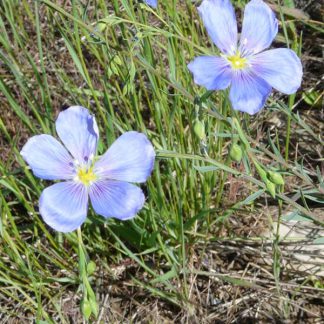
Linum lewisii / wild blue flax
- intense blue, 5-petaled flowers
- red-ish or darker blue veins in petals
- buds, flowers and developing fruit present at same time
- narrow, sessile, 1 inch (ish) leaves
- especially on roadsides and in meadows in the Valley
-

Mahonia repens / creeping Oregon grape
- pinnately compound with toothed, holly-like leaflets
- clusters of yellow flowers in spring; blue berries in late summer
- low, creeping shrub
- evergreen - but winter leaves are reddish
-

Paxistima myrsinites / Oregon boxwood
- low shrub
- small, opposite leaves; lightly toothed, leathery, oval
- very early spring flowering
- teeny flowers with 4 red petals, 4 yellow stamens; in clusters
- usually on open, dry, sunny sites or open forests
-
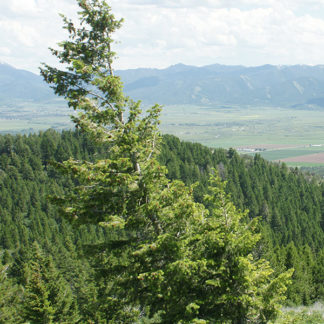
Picea engelmannii / Engelmann spruce
- common, especially in mixed conifer forests
- canopy a narrow spire in young trees, cylindrical in older trees
- sharp, pointy needles, generally "swept" toward branch tips
- needles attached to twigs with woody pegs (sterigmata)
- pendant cones less than 2.5 inches long; thin scales, wavy margins
-
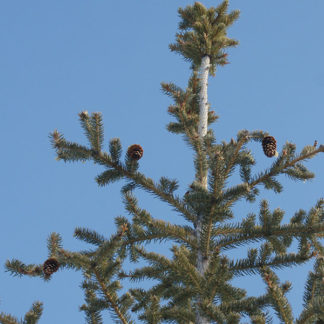
Picea pungens / Colorado blue spruce
- conical, layered crown; whorled branches
- frequent epicormic branches; "woolly" look
- stout, yellow-brown twigs with sterigmata (woody pegs)
- cones greater than 2.5" long
- cone scales stiff at base, diamond shaped, not wavy at tips
- in mixed conifer forests
-

Pinus contorta / lodgepole pine
- evergreen conifer
- needles in groups (fascicles) of 2
- lopsided cones, (mostly) remain on tree when mature
- rounded crown; orangey-brown scaly bark
-
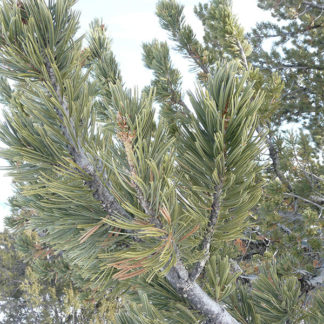
Pinus flexilis / limber pine
- high elevation, rocky or talus, dry, high-stress habitat
- often - stunted and deformed by wind
- highly flexible branches
- needles in bundles (fascicles) of 5
- often - semi-rotted cones on ground below
-
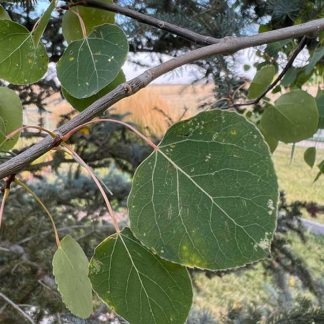
Populus tremuloides / quaking aspen
- white barked, often growing in large clones
- leaves flat with long, flat petiole at 90˚
- leaves quake in even light breezes
- twigs and buds reddish, long and pointed
- catkin flowers in very early spring
- leaves turn yellow or reddish or orange-ish in fall
-

Potentilla fruticosa / shrubby cinquefoil
- low, deciduous, shrub; wetlands and riparian zones
- yellow buttercup-like flowers with 5 leaflets, often in clusters
- blooms from June until frost
- pinnately compound leaves, typically with 5 leaflets
- fruit (achene) remains into winter
-

Pseudotsuga menziesii / Douglas fir
- persistent cones with distinctive 3-pronged, "mouse tail", bracts
- semi-pointy, but not stiff or sharp, single needles
- needles attached to twigs by petioles (no pegs)
- oval leaf scars
- twig buds are pointy, "lustrous" brown
Showing 13–24 of 30 results